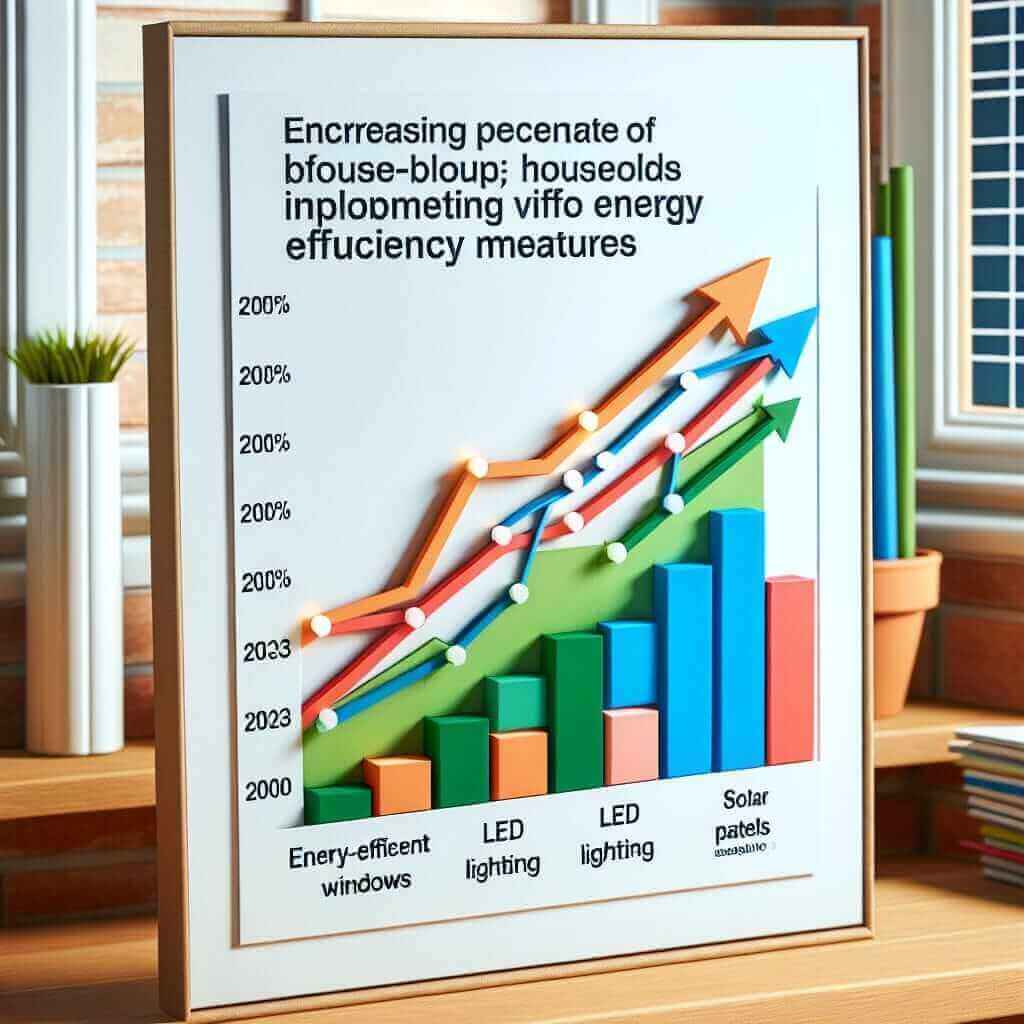In recent years, the topic of “Trends in Household Energy Efficiency Improvements (2000-2023)” has become increasingly relevant, especially in the context of global efforts to combat climate change. In the IELTS Writing Task 1, candidates often encounter tasks that require them to describe trends and changes over a period of time. Understanding such a topic not only boosts your knowledge but also helps you perform better in the exam. Let’s delve into this topic by exploring from an IELTS perspective.
Sample Task 1 Prompt
The chart below shows the trends in household energy efficiency improvements in the period between 2000 and 2023. Summarise the information by selecting and reporting the main features, and make comparisons where relevant.
To create a realistic and detailed chart, we’ll use data from various reliable sources on energy efficiency trends.
Sample Data Representation
Let’s assume the data are presented in a line graph showing the percentage of households adopting various energy efficiency improvements over the years.
Graph Data Description
- Insulation: In 2000, around 30% of households had proper insulation. This percentage increased steadily to 70% by 2023.
- Energy-efficient windows: This saw an increase from 20% in 2000 to 60% in 2023.
- LED lighting: Initiated at 5% in 2000, it witnessed a sharp increase to 80% by 2023.
- Solar panels: Starting from nearly 0% in 2000, the adoption gradually increased to 35% by 2023.
This hypothetical data can visualize the trends better.

Analyzing the Task
- Identify Key Trends: Notice the general trends in the data – upward or downward.
- Group Information: Group related information together for a clear presentation.
- Compare and Contrast: Make meaningful comparisons between different categories and timeframes.
Sample Answer
The line graph illustrates the proportion of households implementing various energy efficiency improvements between 2000 and 2023.
Overall, there has been a significant increase in the adoption of all four energy efficiency measures over the period. Notably, LED lighting and insulation saw the most pronounced rise among the methods.
In 2000, only 5% of households used LED lighting. However, this number rose dramatically to 80% by 2023, making it the most widely adopted energy efficiency measure. Insulation began with 30% of households and grew steadily to 70% by 2023, showing a consistent upward trend.
Energy-efficient windows also witnessed a noticeable increase from 20% in 2000 to 60% in 2023, reflecting a growing recognition of their benefits. Solar panels, though starting from nearly 0%, increased to 35% by 2023, indicating a gradual but steady uptake among households.
In conclusion, the data clearly shows a substantial improvement in household energy efficiency practices, with LED lighting and insulation leading the way.
Word Count: 175 words
Writing Tips
- Use Vivid Vocabulary: Words like ‘significant’, ‘dramatic’, ‘steady’, ‘notable’, ‘pronounced’, and ‘gradual’ effectively describe trends.
- Appropriate Use of Tenses: Use past tenses (simple past, present perfect) to describe trends that continued over time.
- Linking Phrases for Clarity: Use linking words such as ‘Overall’, ‘Notably’, ‘However’, ‘In conclusion’ for better flow and coherence.
Important Vocabulary
- Pronounced (adj.) – nổi bật /prəˈnaʊnst/
- Substantial (adj.) – đáng kể /səbˈstænʃəl/
- Gradual (adj.) – dần dần /ˈɡrædʒuəl/
- Steadily (adv.) – đều đều /ˈstɛdɪli/
- Uptake (n.) – sự tiếp nhận /ˈʌpteɪk/
- Adoption (n.) – sự chấp nhận /əˈdɒpʃən/
- Dramatically (adv.) – đột ngột /drəˈmætɪkli/
- Recognize (v.) – nhận ra /ˈrɛkəɡnaɪz/
- Implement (v.) – triển khai /ˈɪmplɪˌmɛnt/
- Enhance (v.) – cải thiện /ɪnˈhɑːns/
Conclusion
Mastering the description of trends over time is crucial for achieving a high score in the IELTS Writing Task 1. Practice with different datasets and use a variety of vocabulary and structured sentences to convey clear, concise, and insightful comparisons. Aim for coherence, clarity, and a seamless flow of information to impress the examiners and aim for Band 7+.